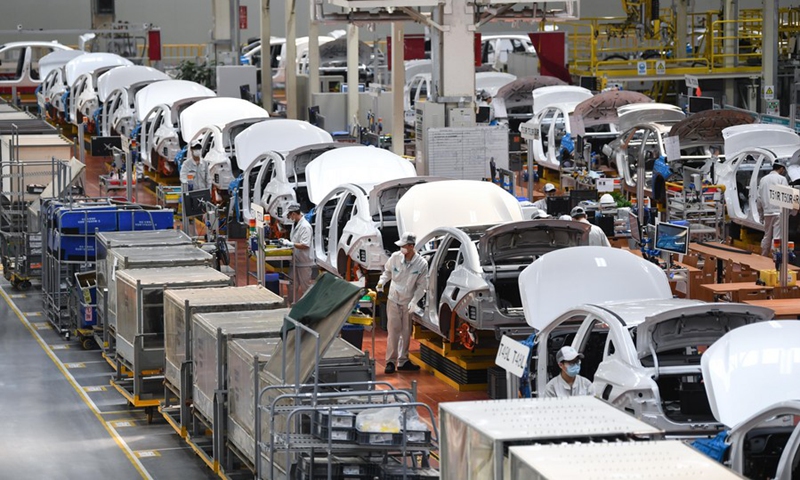
This photo taken on Feb 24, 2023 shows the assembly line of GAC Aion, an NEV subsidiary of Guangzhou Automobile Group Co., Ltd. (GAC Group), in Guangzhou, south China's Guangdong Province. Photo: Xinhua
Allegations of so-called overcapacity relating to China-made electric vehicles (EVs) are a pseudo-proposition, and the narrative is falsified and runs counter to the law of the market economy, China's General Administration of Customs (GAC) told a press conference on Tuesday, noting that manufactured green products have contributed to mitigating global climate change.
The GAC cited EVs as an example, as the International Energy Agency estimates that, by 2030, worldwide sales of EVs will reach 45 million, about three times the level in 2023and five times China's EV output in that year.
China doesn't have an "overcapacity" issue when it comes to new-energy products, and these products have enriched the global green supply and marked China's contribution to the global response to climate change, the GAC said.
"Green" has become a distinctive color for the high-quality development of China's foreign trade. Four out of every 10 cars exported from China currently are EVs, seven out of every 10 railroad locomotives are electric models and nearly 90 percent of the storage batteries exported are lithium-ion batteries, making the color of green even brighter, the GAC stated.
In addition to green products, innovation and coordinated regional development also feature in the country's high-quality development of foreign trade in the new era.
In 2023, China's exports of manufactured high-tech products increased by 6 percent year-on-year, accounting for 18.7 percent of the total value of exports.
Independent and innovative brands have enabled Chinese products to gain rising popularity overseas, ranging from traditional horse-faced skirts to multifunctional electronic products. Exports of independently branded products grew by 9.3 percent in 2023, accounting for 21 percent of overall exports, the GAC noted.
Moreover, coordinated regional development has stabilized the foundation of the country's foreign trade. The eastern coast is the ballast stone of China's foreign trade, with imports and exports exceeding 30 trillion yuan ($4.13 trillion) for three consecutive years.
The central and western regions have effectively undertaken the country's industrial transfer, with the share of foreign trade increasing by nearly 7 percentage points. The total trade of the three northeastern provinces has been expanding too, and the growth rate in 2023 was 1.6 percentage points faster than that of the whole country.
Major city clusters such as the Beijing-Tianjin-Hebei region, the Yangtze River Delta and the Guangdong-Hong Kong-Macao Greater Bay Area have become powerhouses for foreign trade, contributing nearly 60 percent of China's foreign trade growth since the 18th Communist Party of China National Congress in 2012.
China's high-quality development has allowed global trade partners to share the opportunities of its mega market.
China's total merchandise trade has ranked first in the world for seven consecutive years, while the country has become a major trading partner of more than 150 countries and regions. The number of foreign trade enterprises has nearly doubled compared with 2012, according to the GAC.
China has been the world's second-largest importer for many years, growing from 11.49 trillion yuan in 2012 to 17.99 trillion yuan in 2023. Since the 18th CPC National Congress, China's cumulative imports have exceeded 150 trillion yuan, with an annual growth of 4.2 percent.
In 2023, China's imports came from more than 200 countries and regions, and imports of agricultural products and electronic and machinery products from least-developed countries jumped exponentially from 2012, the GAC said.
The development of foreign trade is held back to some extent by rising protectionism, and China's opening-up will help advance the global economy. The "small yard, high fence" mindset is isolationist in itself, while openness and sharing is the only way to prosperity and development, the GAC said.
Global Times




